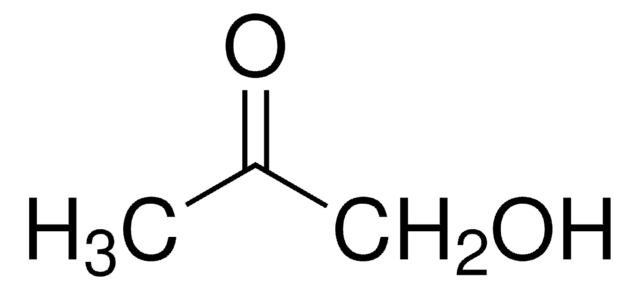おすすめの製品
グレード
certified reference material
pharmaceutical secondary standard
品質水準
認証
traceable to USP 1204102
APIファミリー
dihydroxyacetone
CofA
current certificate can be downloaded
テクニック
HPLC: suitable
gas chromatography (GC): suitable
アプリケーション
pharmaceutical (small molecule)
フォーマット
neat
保管温度
2-30°C
SMILES記法
O1C(COC(C1)(O)CO)(O)CO
InChI
1S/C6H12O6/c7-1-5(9)3-12-6(10,2-8)4-11-5/h7-10H,1-4H2
InChI Key
KEQUNHIAUQQPAC-UHFFFAOYSA-N
類似した製品をお探しですか? 訪問 製品比較ガイド
詳細
Dihydroxyacetone (DHA) is a browning ingredient widely used in cosmetics such as sunless tanning formulations. It participates in a chemical staining reaction called Milliard reaction in which it reacts with the amino groups of proteins to result in a mixture of high molecular weight pigments.
Pharmaceutical secondary standards for application in quality control, provide pharma laboratories and manufacturers with a convenient and cost-effective alternative to the preparation of in-house working standards.
Pharmaceutical secondary standards for application in quality control, provide pharma laboratories and manufacturers with a convenient and cost-effective alternative to the preparation of in-house working standards.
アプリケーション
Dihydroxyacetone may be used as a pharmaceutical reference standard for the determination of the analyte in pharmaceutical formulations by liquid chromatography (LC) technique.
These Secondary Standards are qualified as Certified Reference Materials. These are suitable for use in several analytical applications including but not limited to pharma release testing, pharma method development for qualitative and quantitative analyses, food and beverage quality control testing, and other calibration requirements.
アナリシスノート
このような2次標準は、入手可能な場合にはUSP、EP、BPの1次標準にマルチトレーサビリティを提供します。
その他情報
This Certified Reference Material (CRM) is produced and certified in accordance with ISO 17034 and ISO/IEC 17025. All information regarding the use of this CRM can be found on the certificate of analysis.
脚注
To see an example of a Certificate of Analysis for this material enter LRAC0574 in the slot below. This is an example certificate only and may not be the lot that you receive.
おすすめ製品
Find a digital Reference Material for this product available on our online platform ChemisTwin® for NMR. You can use this digital equivalent on ChemisTwin® for your sample identity confirmation and compound quantification (with digital external standard). An NMR spectrum of this substance can be viewed and an online comparison against your sample can be performed with a few mouseclicks. Learn more here and start your free trial.
保管分類コード
13 - Non Combustible Solids
WGK
WGK 1
引火点(°F)
Not applicable
引火点(℃)
Not applicable
適用法令
試験研究用途を考慮した関連法令を主に挙げております。化学物質以外については、一部の情報のみ提供しています。 製品を安全かつ合法的に使用することは、使用者の義務です。最新情報により修正される場合があります。WEBの反映には時間を要することがあるため、適宜SDSをご参照ください。
Jan Code
PHR1430-1G:
PHR1430-1G-PW:
最新バージョンのいずれかを選択してください:
この製品を見ている人はこちらもチェック
Dihydroxyacetone, the active browning ingredient in sunless tanning lotions, induces DNA damage, cell-cycle block and apoptosis in cultured HaCaT keratinocytes
Petersen AB, et al.
Mutation Research, 560(2), 173-186 (2004)
Influence of hydration on dihydroxyacetone-induced pigmentation of stratum corneum
Nguyen BC and Kochevar IE
The Journal of Investigative Dermatology, 120(4), 655-661 (2003)
Dihydroxyacetone
USP42-NF37: United States Pharmacopeia and National Formulary
United States Pharmacopeia/National Formulary, 1366-1366 (2018)
Megan A Rees et al.
Journal of proteome research, 14(1), 120-132 (2014-10-21)
Interactions between a host and a bacterial pathogen are mediated by cross-talk between molecules present on, or secreted by, pathogens and host binding-molecules. Identifying proteins involved at this interface would provide substantial insights into this interaction. Although numerous studies have
C Flavia Massaro et al.
Journal of agricultural and food chemistry, 62(50), 12209-12217 (2014-11-26)
Australian stingless bee honeys have been shown to exert antioxidant and in vitro antimicrobial properties; however their bioactive factors remained unidentified. This study investigated the antibacterial properties of phenolic extracts from Tetragonula carbonaria honeys. Honeys were harvested from beehives in
ライフサイエンス、有機合成、材料科学、クロマトグラフィー、分析など、あらゆる分野の研究に経験のあるメンバーがおります。.
製品に関するお問い合わせはこちら(テクニカルサービス)








